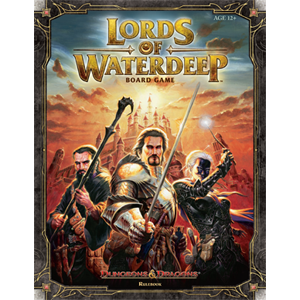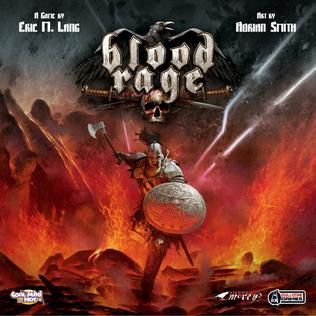
Shogun: Total War is a turn-based strategy and real-time tactics video game developed by The Creative Assembly and published by Electronic Arts for Microsoft Windows personal computers. Released in June 2000, the game became the debut title in The Creative Assembly's Total War series. Set in Japan during Sengoku jidai—the "Warring States" period from the 15th to the beginning of the 17th century—the game has players adopt the leader of a contemporary Japanese clan, attempt to conquer the nation and claim the position of shōgun. The turn-based aspect of the game focuses on a map of Japan where military force, religion, diplomacy, espionage and economics all influence the player's actions, whilst battles are fought in a 3D real-time mode.

Shogun is a board wargame set in feudal Japan, first released in 1986 by game maker Milton Bradley.

Days of Wonder is a board game publisher founded in 2002 and owned by Asmodee Group since 2014. Days of Wonder distributes its games to 25 countries. It specializes in German-style board games and has branched out to include some online games. Days of Wonder has published games in several languages including English, Dutch, French, German, Russian, and Greek. Days of Wonder was co-founded by Eric Hautemont, Mark Kaufmann and Yann Corno.
Battle Cry is a board wargame based on the American Civil War, designed by Richard Borg and published by Avalon Hill in 2000.

Pirate's Cove is a board game designed by Paul Randles and Daniel Stahl, originally published in Germany in 2002 by Amigo Spiele, illustrated by Markus Wagner and Swen Papenbrock. In 2003, Days of Wonder republished the game with a new graphic design from Julien Delval and Cyrille Daujean. In the game, players play pirate ship captains seeking treasure from islands and bragging rights from defeating other pirates in naval combat.

Wallenstein is a medium-weight German-style board game designed by Dirk Henn and published by Queen Games in 2002. Though set during the Thirty Years' War, Wallenstein should not be confused with a complex wargame. Rather, it has the feel of a light strategy game with the familiar Euro elements of area control and resource management mixed in. As such, it has a wide range of appeal that attracts wargamers and non-wargamers alike.

Amun-Re is a game designed by Reiner Knizia and first published in 2003 by Hans im Glück in German and in English by Rio Grande Games.
BattleLore is a strategy board wargame for two players, created by Richard Borg and initially published by Days of Wonder in 2006. The game is based on the same mechanics as Battle Cry, Memoir '44 and Commands & Colors: Ancients, but has a fantasy and medieval theme.

Commands & Colors: Ancients is a board wargame designed by Richard Borg, Pat Kurivial, and Roy Grider, and published by GMT Games in 2006. It is based on Borg's Commands & Colors system using some elements similar to his other games such as Commands & Colours: Napoleonics, The Great War, Memoir '44 and Battle Cry designed to simulate the "fog of war" and uncertainty encountered on real battlefields.
Brass is a board game set in Lancashire, England during the Industrial Revolution. It was developed by Martin Wallace. The goal of the game is accrue the most victory points by building mines, cotton factories, ports, canals and rail links, and establishing trade routes. The game is divided into two historical periods: the canal period and the rail period. Victory points are scored at the end of each.

Balloon Cup is a two-player card game designed by Stephen Glenn and published by Kosmos in 2003.

Lords of Waterdeep is a German-style board game designed by Peter Lee and Rodney Thompson and published by Wizards of the Coast in 2012. The game is set in Waterdeep, a fictional city in the Forgotten Realms campaign setting for the Dungeons & Dragons role-playing game. Players take the roles of the masked rulers of Waterdeep, deploying agents and hiring adventurers to complete quests and increase their influence over the city.

King of Tokyo is a monster movie-themed tabletop game using custom dice, cards, and boards, designed by Richard Garfield and released in 2011. A New York City-based edition, King of New York, was published in 2014. The game was re-released in 2016, with all-new artwork and characters.

Eclipse: New Dawn for the Galaxy is a strategy board game produced by Lautapelit.fi. It was designed by Touko Tahkokallio and first released in 2011. The game currently has three expansions – Rise of the Ancients, released in 2012, Ship Pack One, released in 2013 and Shadow of the Rift, released in 2015 – and four mini expansions. A second edition, titled Eclipse: Second Dawn for the Galaxy was released in 2020 featuring revisions to the rules, graphic design, miniatures, and storage. The first edition is no longer being actively published.

Concept is a deduction party board game released in 2013. The game was designed by Alain Rivollet and Gaëtan Beaujannot and published by Repos Production. It has collected multiple awards and nominations including the Jeu de l'Année prize in Cannes in 2014.

Colt Express is a railway-themed family board game designed by Christophe Raimbault, Illustrated by Ian Parovel and Jordi Valbuena, published in 2014 by Ludonaute and distributed by Asmodee.

Blood Rage is a Viking themed board game designed by Eric Lang and published by CMON Limited in 2015. Each player controls a clan of mythological Vikings seeking glory as Ragnarok approaches. Played in three ages or rounds, Blood Rage features card drafting, battles and territory control via forces represented by sculpted plastic miniatures. All conflicts are resolved through playing cards, and cards are also used to improve and differentiate the different clans and the leaders, warriors, ships and monsters at their command.
Keyflower is a Euro-style board game designed by Sebastian Bleasdale and Richard Breese, and originally published by R&D games in 2012. It can be played by 2-6 players. In this game, players use their workers to try to build the best village among the players, by earning the most victory points in 4 rounds. The game features strategic use of workers, where players use them both for bidding for new village tiles and to use them. It has received numerous honors, and is ranked as the 50th best game in BoardGameGeek as of 2019.

Honor of the Samurai is a card game published by Gamewright in 1996 with a feudal Japanese setting that uses the themes of honor and family.
Battles of Westeros is a 2010 strategic wargame set in George R.R. Martin’s A Song of Ice and Fire universe. It was designed by Robert A. Kouba and published by Fantasy Flight Games.
















